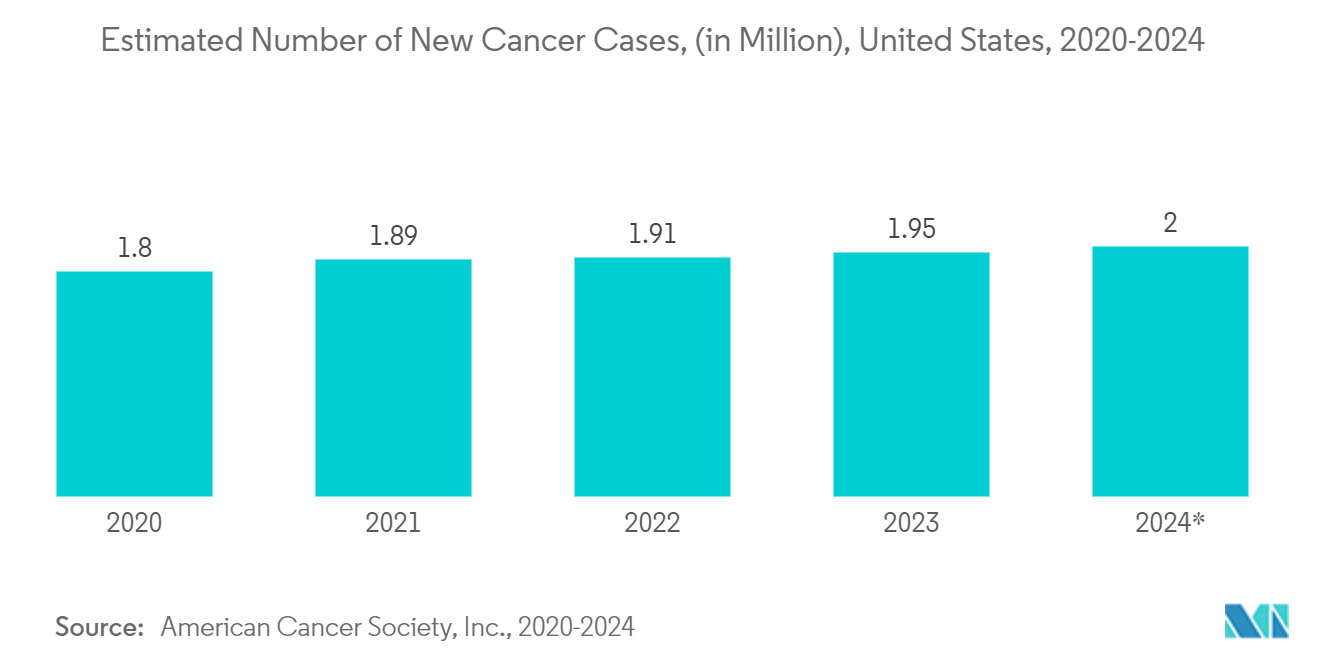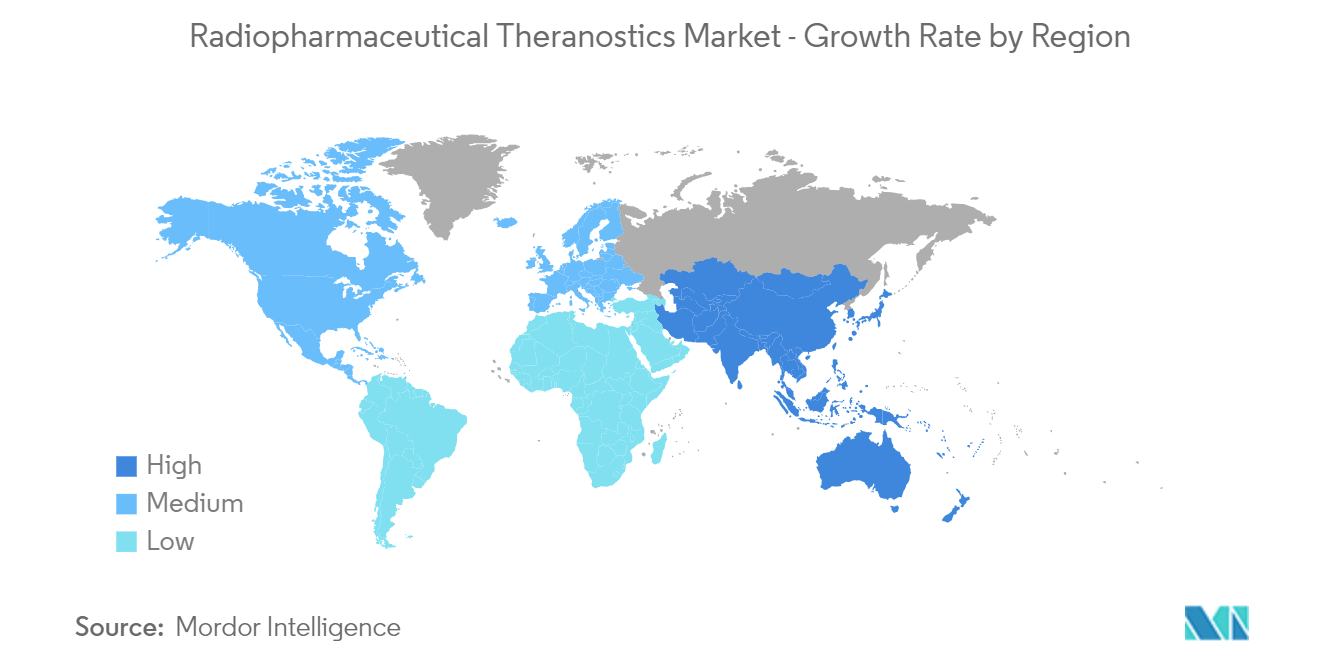Market Trends of Radiopharmaceutical Theranostics Industry
The Companion Diagnostic Radiopharmaceuticals Segment is Expected to Dominate the Radiopharmaceutical Theranostics Market During the Forecast Period
Companion diagnostic radiopharmaceuticals are specialized imaging agents used in conjunction with targeted therapies to assess the presence or expression of specific biomarkers or molecular targets in patients. These radiopharmaceuticals help identify patients most likely to benefit from a particular treatment, such as targeted therapy and personalized medicine, thereby optimizing therapeutic outcomes and minimizing unnecessary exposure to ineffective treatments.
The increasing emphasis on personalized medicine, innovations in imaging technologies and radiopharmaceutical development, and the growing prevalence of cancer drive the segment.
The increasing use of PET imaging in diagnostics has driven the growth of companion diagnostics radiopharmaceuticals, which are critical for early and accurate diagnosis of diseases like cancer. For instance, as per IMV PET report 2024, from 2022 to 2023, the average number of PET scans conducted per fixed PET site rose by 6.7%, climbing from an estimated 1,401 scans in 2022 to 1,495 in 2023 in the United States. Looking ahead, 67% of PET sites expect an uptick in their procedure volumes over the coming year. Thus, growing PET imaging diagnosis is expected to contribute to segment growth.
Further, innovations in imaging technologies and radiopharmaceutical development enhance the accuracy and effectiveness of companion diagnostics. For instance, as a study published in Science in August 2023, molecular imaging techniques, such as PET and MRI, are increasingly used in conjunction with companion diagnostics to monitor treatment responses dynamically. This integration allows for real-time assessment of tumor heterogeneity and therapeutic efficacy, improving patient management in oncology. Innovations focus on improving specificity and therapeutic effectiveness through novel targeting agents and better radionuclide selection, which can minimize damage to healthy tissues while maximizing treatment efficacy.
In addition, in April 2024, BAMF Health and Nihon Medi-Physics Co. Ltd announced that the first patient in the world was imaged at BAMF Health using the novel molecular imaging agent NMK89 developed by NMP as part of a clinical trial. BAMF Health was chosen, in part, because it had the most advanced total-body PET/CT scanner in the world. Thus, advanced technologies such as PET and SPECT, which are increasingly used in conjunction with companion diagnostics radiopharmaceutical, are likely to contribute to segment growth over the forecast period.
The strategic activities of industry players, such as introducing new companion radiopharmaceuticals, mergers and acquisitions, and collaborations, are expected to increase access to new products, contributing to segment growth. For instance, in June 2024, Lantheus Holdings Inc. acquired global rights to Life Molecular Imaging's RM2, which targets the gastrin-releasing peptide receptor (GRPR). This includes the associated novel, clinical-stage radiotherapeutic, and radiodiagnostic pair, known as 177Lu-DOTA-RM2 and 68Ga-DOTA-RM2 (companion diagnostics). With this acquisition, Lantheus not only bolsters its foothold in prostate cancer but also broadens its pipeline to encompass breast cancer and potentially other malignancies. The deal, valued at an upfront payment of USD 35 million, grants Lantheus global rights to the radiotheranostic pair, alongside potential regulatory milestone payments and royalties.
Similarly, in October 2023, GE Healthcare announced collaborations with SOFIE Biosciences and Nucleus RadioPharma that will play an even larger role in developing and marketing the next generation of molecular imaging pharmaceuticals. SOFIE took this approach through the clinical development of two diagnostic agents called [68Ga]FAPI-46 and [18F]FAPI-74.
Thus, such innovations and collaborations between pharmaceutical and diagnostic companies promote the development and adoption of companion diagnostics, boosting segment growth.

North America is Expected to Dominate the Radiopharmaceutical Theranostics Market
North America's leadership in the radiopharmaceutical theranostics market is propelled by a combination of advanced healthcare infrastructure, research excellence, high disease prevalence, regulatory support, strategic collaborations, and a commitment to adopting cutting-edge technologies in the healthcare sector. These factors collectively position the region as a frontrunner in shaping the future of theranostics solutions for precision medicine.
The landscape of radiopharmaceutical theranostics has notably advanced since the US Food and Drug Administration (FDA) approved radionuclides for treating neuroendocrine tumors and prostate cancer. According to a March 2024 article by Science and Medicine Group, theranostics has gained significant traction, driven by positive research outcomes and the adoption of key radionuclides like gallium-68 (Ga-68) and lutetium-177 (Lu-177). These advancements are fostering rapid progress in the field, positioning theranostics as a potential cornerstone in cancer therapy.
The favorable reimbursement policies enhance accessibility, and the adoption of Lu-177 therapies is anticipated to boost the segment's growth. For instance, as per the state of Lowa Department of Health and Human in September 2023, Lutetium Lu 177 Dotatate (Lutathera) is covered by Medicaid and North Carolina Health Choice programs. It has a maximum reimbursement rate of USD 51,300 per vial (7.4 GBq) when billed with HCPCS code A9699. Lutathera is indicated for treating somatostatin receptor-positive neuroendocrine tumors and is administered every eight weeks for up to four doses.
Similarly, Lutetium Lu 177 Vipivotide Tetraxetan (Pluvicto) agent is also covered under Medicaid, with a maximum reimbursement of USD 229.50 per mCi. It is indicated for metastatic castration-resistant prostate cancer and is administered every six weeks for up to six doses. These reimbursement structures reflect the growing demand for targeted radioligand therapies in oncology and are likely to contribute to segment growth over the forecast period.
Strategies by market players continue to bolster the momentum in the radiopharmaceutical industry. For example, in July 2024, Radiopharm Theranostics secured FDA Investigational New Drug (IND) approval for a Phase 2b imaging trial of F18-Pivalate (RAD 101) targeting brain metastases. This milestone underscores the broadening scope of radiopharmaceutical applications, extending beyond conventional cancer types, and significantly impacts the growth of the radiopharmaceutical theranostics market.
Canada's radiopharmaceutical theranostics industry is experiencing heightened activity. In a notable move, ISOLOGIC Innovative Radiopharmaceuticals unveiled a significant investment of CAD 29.9 million (USD 22 million) in June 2024. This capital injection is set to fortify the radiopharmaceutical landscape, enhance Quebec's pivotal position in Canada's medical isotope supply chain, and drive growth in the radiopharmaceutical theranostics market. The investment is expected to address critical supply chain challenges and meet the increasing demand for PET diagnostic radioisotopes throughout Canada. This initiative highlights the growing importance of radiopharmaceuticals in the country's healthcare ecosystem and reflects a broader commitment to advancing nuclear medicine.
In conclusion, North American companies and research institutions lead the way in advanced technology development. Factors such as key product launches, a dense concentration of market players, and a strong manufacturer presence in the United States are propelling the growth of the radiopharmaceutical theranostics market in the region. Given these dynamics, North America is poised for continued market expansion.


